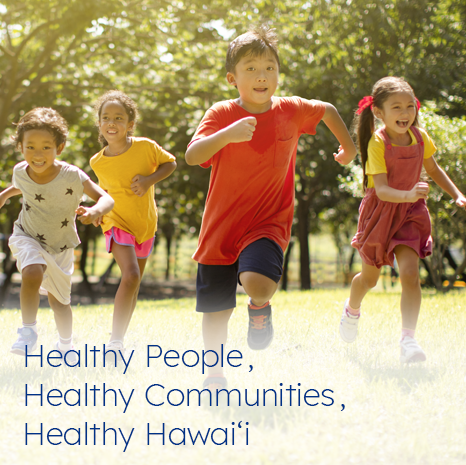Your message has been forwarded to our team and we will respond to you shortly.
The Hawaiʻi Heart Disease and Stroke Plan (HDSP) 2030 represents a coordinated effort between stakeholders and partners throughout the state, who worked together to develop objectives and strategies that utilize data, best practices, and evidence-based science. The resulting HDSP 2030 reflects a common vision for preventing and managing heart disease and stroke to help the people of Hawaiʻi, especially those most at-risk, lead healthy lives.
Cardiovascular disease is a widespread and serious problem in both Hawaiʻi and the United States. Cardiovascular disease is a group of disorders related to the heart and blood vessels, and is the leading cause of death in Hawaiʻi.55 Across the nation, one person dies every 37 seconds from cardiovascular disease.56 Two of the most common and deadly forms of cardiovascular disease include heart disease and stroke.
- High blood pressure
- High blood cholesterol
- Smoking
- Type 2 diabetes
- Poor diet and physical inactivity
- Overweight and obesity
and Stroke Priority Populations
- Native Hawaiians
- Filipinos
- Other Pacific Islanders
- Medicaid Beneficiaries
Despite Hawaiʻi being ranked third in the nation for heart health, there is still much more work to be done.57 Hawaiʻi has a large population of at-risk groups, such as Native Hawaiians and Other Pacific Islanders, who have higher rates of coronary heart disease, angina, history of a heart attack, and heart attack deaths than Caucasian persons.58, 55
The HDSP 2030 incorporates principles of the Social Ecological Model and is organized into four sector areas: Community Design and Access, Education, Health Care, and Worksite. The plan prioritizes goals, objectives, and strategies that lead to policy, systems, and environmental change. Objectives were developed using current data, best practices, and evidence-based science, and reflect one or more cross-cutting themes.
The HDSP 2030 is meant to be a living document that is reviewed and updated throughout the plan’s timeframe. Implementation of the plan will be a collective effort by individuals and organizations across the state.
Develop and deliver at least two promotional activities to increase awareness of the preventability of heart disease and stroke.
- Identify partners to establish a communications workgroup
- Convene communications workgroup regularly to develop messages tailored for targeted audience
- Identify media outlets that will reach targeted audience
- Disseminate messages through promotional activities (e.g., social media messages, posters, brochures, or other printed materials) and evaluate messages
Adopt a wellness policy designed to provide access to blood pressure cuffs and blood pressure education at public college campuses.
- Leverage partnerships within the University of Hawaiʻi system to identify campus wellness/health services coordinator
- Explore potential partnerships and link available resources at American Heart Association
By 2025, identify at least five measurable outcomes indicative of team-based care and monitor over time.
- Identify key partners to establish a team-based care workgroup
- Convene team-based care workgroup regularly to identify measurable outcomes indicative of team-based care
Implement at least 3 team-based care priorities.
- Implement priorities identified by the team-based care workgroup (e.g., use of pharmacists in medication management to increase physical patient panels, use of non-physician workforce for Asthma Self-Management (ASME) and other chronic disease prevention and management, or use of Community Health Workers (CHW) in patient care coordination, use of school health aides and school-based health services, and expansion of academic programs and professional development)
Establish coverage for medication therapy management and/or self-measured blood pressure monitoring by Medicaid.
- Identify and review existing literature/guidance on Medication Therapy Management (MTM) and Self-Measured Blood Pressure Monitoring (SMBPM) reimbursement
- Collaborate with Medicaid and provide guidance on reimbursement for MTM and/or SMBPM
By 2025, identify at least six Health Information Technology priorities to enhance population health.
- Identify key Health Information Technology (HIT) partners to establish a HIT workgroup
- Convene HIT workgroup regularly to identify the HIT priorities to enhance population health
Implement at least 3 Health Information Technology priorities.
- Implement priorities identified by the HIT workgroup (e.g., telehealth, remote patient monitoring, use of clinical decision support tools, use of population health management, use of patient portals or engagement and education resoures, Artificial Intelligence)
Establish at least one statewide policy designed to increase access to evidence-based chronic disease prevention and management programs that address heart disease and stroke at worksites.
- In collaboration with Objective Heart Disease and Stroke-09, identify partners to establish an advisory group to develop a Hawaiʻi-specific worksite wellness recognition policy
- Convene workgroup regularly to draft a policy
Implement a statewide, comprehensive worksite wellness recognition program that at least 10 very small-, 15 small-, 10 medium-, and 5 large-employers will participate in.
• Identify partners and convene an advisory group to develop a Hawaiʻi-specific, evidence-based worksite wellness recognition program that includes the following areas:
o Asthma
o Cancer
o Diabetes
o Heart Disease and Stroke
o Physical Activity and Nutrition
o Tobacco
• Pilot the recognition program with a group of diverse employers and modify the program based on their feedback.
| Baseline | Target | Status Date- 07/01/2025 | |
|---|---|---|---|
| Very Small | 0 | 10 | 0 |
| Small | 0 | 15 | 0 |
| Medium | 0 | 10 | 0 |
| Large | 0 | 5 | 0 |
| Activities | Responsible Parties | Completed By |
|---|---|---|
| 1. Convene an advisory group to develop a Hawai‘i specific, comprehensive WSW recognition program that will include all aspects of health | HIPHI; AlohaCare; HMSA; Kaiser; UHA Health Insurance; DOH | 2024 |
| 2. Pilot recognition program with a group of diverse employers | HIPHI; AlohaCare; HMSA; Kaiser; UHA Health Insurance; DOH | 2025 |
| 3. Establish infrastructure for program at the DOH, statewide | DOH | 2025 |

The long-term measures are broad measures that help assess progress toward achieving the Healthy Hawaiʻi Vision 2030.